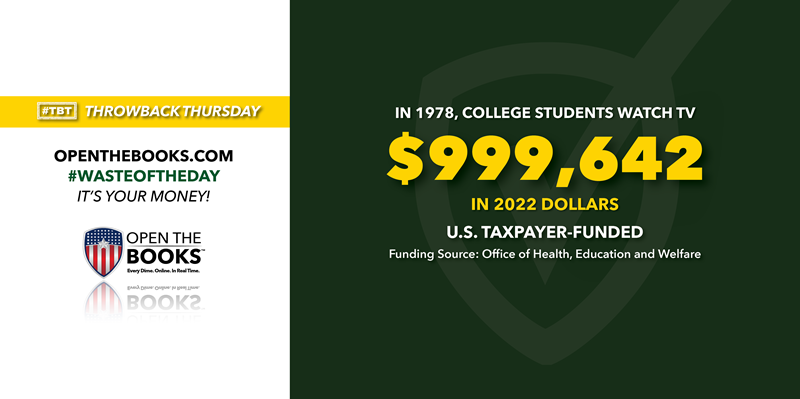
San Francisco Spending $1.7M for a Single Public Toilet
October 31, 2022

The cost for a single public toilet in a 150-square-foot space for San Francisco’s Noe Valley Town Square just came in at an eye-watering $1.7 million — with a completion date set for 2025, according to The New York Post.
In contrast, New York’s iconic Empire State Building, the 1st 100 story building, was built in one year and 45 days. Framing went up at four and half stories — a week.
Not to be a party pooper but, come on San Francisco, you’re better than this. City officials seems to know it.
A celebration set at the site to hail final approval of the new public toilet was cancelled, with the assemblymember who secured the funds, Matt Haney (D-San Francisco), calling the final price tag “shockingly high” and “inexplicable” in the San Francisco Chronicle.
“I’m glad that Noe Valley will at some point get a bathroom, but it shouldn’t cost this much and it shouldn’t take this long, and I’m angry about it,” Haney told the Chronicle. “It’s not something I want to celebrate right now.”
Residents have asked for a toilet since the plaza opened in 2016, but no one expected a $1.7 million pricetag or its 2025 opening date.
The Chronicle said, “the commode kerfuffle is just one recent example of a city bureaucracy so overly complicated and enamored of process that nothing seems to get done.”
In the Post, when asked to guess the cost, area builder Tom Hardiman of the Modular Building Institute said, “I’m going to guess high, I think, and say $200,000.”
When told of the $1.7 million price tag, 8.5 times higher than his estimate, he added, “It would be comical if it wasn’t so tragically flawed.”
A spokesperson for the San Francisco Recreation and Parks Department attributed the staggering price to “onerous demands and unpredictable costs levied by PG&E,” sky high construction costs that have increased 20-30 percent in two years, and high pay and benefits for workers, Fox News reported.
Hawaii Gets $1M for Sea Urchin Hatchery
November 1, 2022

When Congress passed three massive spending bills for Covid-19 relief, it gave wide latitude to what states and localities could do with that money. Too much latitude in some cases.
In Hawaii, a sea urchin hatchery “working to properly care and restore an important part of the local ecosystem and economy” received $1 million in 2022.
What does that have to do with Covid-19 recovery? Unclear.
The state received plenty of funding for pandemic-related spending. It received $700 million from the American Rescue Plan Act in fiscal year 2022 “to repay the unemployment insurance loan principal” as well as $5.3 million in FY 2023 “to repay the federal unemployment insurance loan interest.”
The state received $313 million in fiscal year 2023 “to repay a working capital loan,” as well as about $1 million for worker’s compensation claims, among many other grants.
Otherwise legitimate spending in the Aloha State was inappropriate when put under the “pandemic aid” microscope.
Hawaii receives $120,000 annually for its Native Resources and Fire Protection Program; $1.2 in FY 2022 to fund economic analysis at the University of Hawaii Economic Research Organization; $4 million annually for economic planning and research; and $11 million annually for Convention Center operations.
It’s also getting $9.7 million annually “for centralized vacation payout statewide” and $520,000 each year for operations at the Hawaii Youth Correctional Facility.
Some estimates say only 10 percent of the $4.6 trillion given to state and local governments have been spent on pandemic-related issues.
State Dept. Gives Ecuador $20,600 for Drag Shows
November 2, 2022

In a head-scratcher grant that epitomizes mission creep, the U.S. State Department awarded $20,600 for a cultural center in Ecuador to host drag theater performances to “promote diversity and inclusion” in the region, Fox News reported.
The project, run by Centro Ecuatoriano Norteamericano, a non-profit organization supported by the U.S. Embassy and Consulate in Ecuador, runs September 2022 through August 2023. It includes three workshops, 12 drag theater performances, and a 2-minute documentary, according to the grant.
“The United States and Ecuador share a history of partnership and cooperation, and have mutual interests in economic prosperity, democratic governance, regional security, and academic exchanges,” according to the State Department’s own website. “The protection of American citizens and U.S. interests remains the top mission priority.”
It is unclear how the grant does any of that or how it will further the objective of the State Department’s Public Diplomacy Programs.
The objective is “to support the achievement of U.S. foreign policy goals and objectives, advance national interests, and enhance national security by informing and influencing foreign publics and by expanding and strengthening the relationship between the people and government of the United States and citizens of the rest of the world.”
While the Ecuadorian organization has been generously supported with hundreds of thousands of U.S. taxpayer dollars in recent years, including $234,000 given in 2015 for the building of a new auditorium, the new initiative is the first one funding a drag performance.
Throwback Thursday: In 1978, Funds for Teaching College Students to Watch TV
November 3, 2022

Throwback Thursday!
In 1978, what was then known as the Office of Health, Education and Welfare, or HEW, spent $219,592 — $999,642 in 2022 dollars — to teach college students how to watch television, earning the office a Golden Fleece Award.
Sen. William Proxmire, a Democrat from Wisconsin, gave awards to wasteful and nonsensical spending, eventually handing out 168 Golden Fleece Awards between 1975 and 1988.
HEW existed from 1953 to 1979 and later split into the Department of Education and Department of Health and Human Services.
The grant at the time was used to “enable college students to … distinguish between television’s fact and fiction, recognize its various viewpoints, and evaluate its messages,” according to the contract.
“Rather than teaching the undergrads … how to look at the tube, it would perhaps be better for both students and the taxpayers if this contract went down the tube,” Proxmire said then.
While students would be tempted to take TV Viewing 101 for an easy A, the Office of Education deserves an F, Proxmire said.
“If a student’s critical viewing skills have not been sufficiently developed by college age so he or she can understand (in the words of the proposal itself) ‘how weekly viewing of "Rhoda" affects the viewer’s attitude toward divorce, or more broadly, toward feminism’ one doubts seriously whether development by the federal government of this curriculum will help,” the senator said.
He noted that the office has developed some “outstanding” TV programs, including Sesame Street, spending $823,651 to develop “critical television viewing skills” at the elementary, middle, secondary and post-secondary school levels. He said there may be some justification for the elementary, middle, and secondary spending.
“But the spending of $219,000 for the college program gets such low ratings it should be cancelled,” he said. “If education has failed to endow college students with critical faculties which can be applied to the spectrum of their lives, a series of new courses on how to watch television critically will not provide it.”
Florida Man Stole $2.6M Covid-19 Relief Funds
November 4, 2022

A Florida man allegedly filed fake payroll, tax documents, and a commercial lease to scam his way into getting $2.6 million in Covid-19 relief from the federal government, using it to buy two houses in Naples, Florida, stocks and investment securities, a 2019 Tiara 34LS boat, a 4.02 carat engagement ring, and ammunition.
Daniel Joseph Tisone, 35, is a convicted felon and prohibited from possessing ammunition, the Department of Justice said, but FBI agents and agents of Special Inspector General for Pandemic Recovery found 800 rounds of assorted ammunition in his house.
Between March 2020 and April 2021, Tisone submitted fake forms to the Small Business Administration for Economic Injury Disaster, Main Street Lending Program, and Paycheck Protection Program loan applications, prosecutors said.
He lied on the applications in numerous instances, including about his criminal history, average monthly payroll, number of employees and his gross revenue, the DOJ alleges.
To support his applications, he allegedly made up fake payroll and tax documents, as well as a fake commercial lease. He submitted fake names, dates of birth, and Social Security numbers for his alleged employees.
With this, he receive one Main Street Lending Program loan, four Economic Injury Disaster loans, and five Paycheck Protection Program loans, totaling $2.6 million deposited into his bank accounts, according to the DOJ.
He pleaded guilty in Fort Myers federal court to wire fraud, bank fraud, illegal monetary transaction and possession of ammunition by a convicted felon, and faces up to 60 years in federal prison at a hearing scheduled for Dec. 5.
As part of his plea agreement, Tisone must pay back the money and forfeit the homes, boat, and ring, the Associated Press reported.
This is just one instance of many where criminals took advantage of lax requirements and little-to-no checks as the federal government dispersed aid during the pandemic.
The #WasteOfTheDay is presented by the forensic auditors at OpenTheBooks.com.